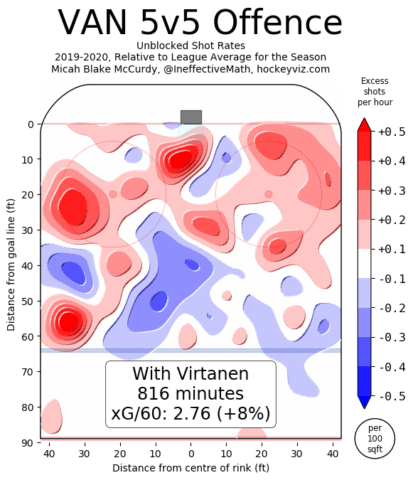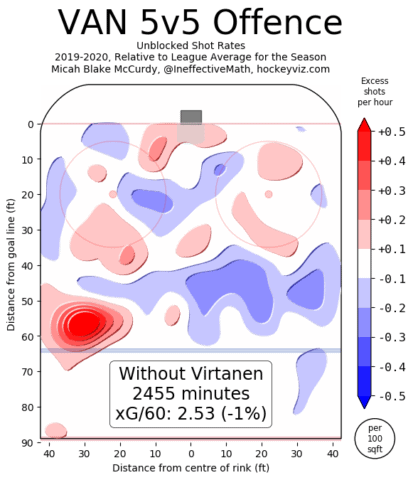We’re into the second week of NHL summer training camps and Jake Virtanen is already making headlines for all the wrong reasons.
The former 2014 sixth-overall draft pick was in the news after captain Bo Horvat ripped into him during the Vancouver Canucks’ first scrimmage on July 16. Check out the audio below, you can clearly hear Horvat yell at Virtanen, even over the commentary.
It’s no secret Virtanen had a tough scrimmage. The Athletic’s Harman Dayal pointedly said as much in his post-game article:
“There’s no need to start ringing alarm bells, but yes, Virtanen’s disappointing defensive play was one of the biggest things that stood out.”
Harman Dayal on Jake Virtanen’s first scrimmage.
The play that had people talking was when Chris Tanev and Quinn Hughes easily walked around Virtanen and scored on Jacob Markstrom. There’s a video of the play on the Canucks’ Twitter account, around the 28-second mark.
The scrimmage has left Canucks fans and the media ravenously discussing the possibility of movingVirtanen in the offseason. While that may be a knee-jerk reaction to one bad scrimmage, I don’t disagree with the sentiment.
What Virtanen Does Well
In March, I wrote another piece on Virtanen talking about how his play had really started improving this season. Offensively, I still believe that to be the case. He showed more this season than he has previously and, at the time, I figured it could be sustainable.
Virtanen was a strong offensive player at five-on-five this season. From the heatmaps above, we can see Vancouver was eight percent more dangerous with him on the ice, particularly right in front of the net. The Canucks struggled a bit to generate shots when he was on the bench, they generally broke-even without him.
This checks out when we look at the data manually tracked by Corey Sznajder for the All-3-Zones Project. In his minutes tracked, Virtanen generated shots at an elite rate. He compares favorably to other upcoming free agent teammates.
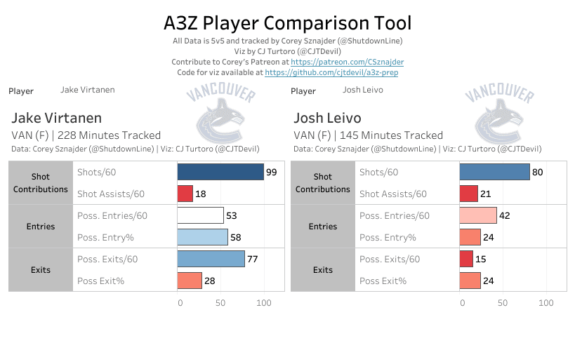
Even looking at even-strength points, Virtanen ranked fifth among Canucks forwards with 26 points. More interestingly, he ranks second in individual points percentage (IPP, which measures the frequency in which a player records a point while they are on the ice). His 83.87 IPP is extremely high, meaning he was nearly always a factor in the offence when a goal was scored.
Related: Red Wings’ 3 Best Agitators of the Modern Era
Virtanen has the raw tools to be an elite player. His size and power are obvious and he has no problems throwing his weight around. He was fourth on the team with 102 hits, many of them punishing.
The most striking thing about Virtanen is his speed for such a big man. Speed is what separates his game from similar players; he’s able to use it effectively to generate offence. Before this season, his speed helped him be an elite puck carrier and offensive generator. We can see this using the A3Z again; he was a dominating puck carrier while still having an elite shot rate.
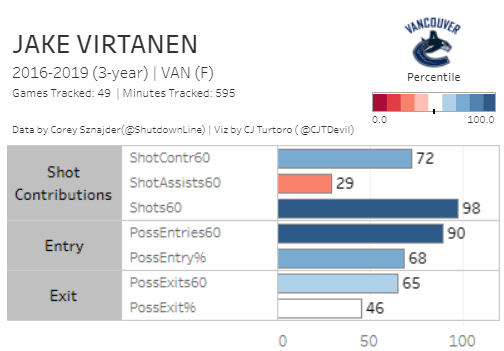
Virtanen has the tools, no question about it. The problem for him is knowing how to put it all together.
Areas to Improve
Warts in Virtanen’s game have long been covered and I don’t want to continue beating that drum, but it’s important to highlight some of the issues that hold him back from reaching his full potential.
Let’s start with his five-on-five defense, which is horrific. Virtanen doesn’t have a sterling defensive reputation as it is, but it becomes even more glaring when you see shot maps.
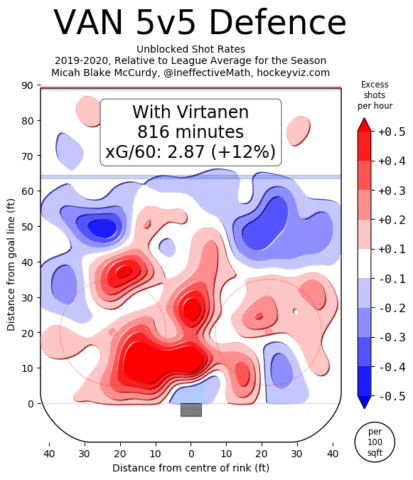
That dangerous-looking red blob right in front of the net means opponents are taking a high volume of shots from there when Virtanen is on the ice. Opposing teams’ shots are about 12 percent more dangerous when he is on the ice.
Related: Best Blackhawks’ Draft Picks – 2010 to Present
Looking at Evolving-Hockey’s goals above replacement (GAR) model, much of Virtanen’s lost value is on the defensive side. His defensive game is bad enough that it nearly outweighs all the positives, including his power-play offence and ability to draw penalties.
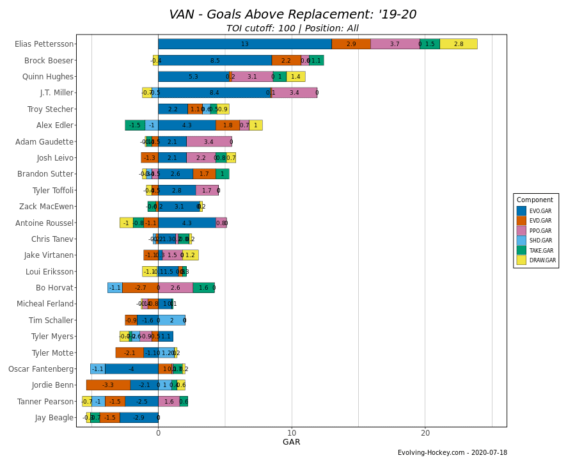
Virtanen’s hockey sense has been in question since his draft year, and it’s still fair to question it six years later. Too often he makes a great play, using his speed to gain the offensive zone, but skates the puck into danger or takes a seemingly harmless shot. Plays like these separate good players from great ones: great players would read the situation and try and make the best play, whether it’s the shot or finding an open teammate.
Those harmless shots could be artificially inflating his shot metrics as well. Given his play-driving, it was expected Virtanen would have scored about two more goals than he did this season, bumping his adjusted season total to 24 goals. We can see this using Evolving-Hockey’s regularized adjusted plus-minus (RAPM) method; simply put, Virtanen should have scored more given how many shots he was taking.
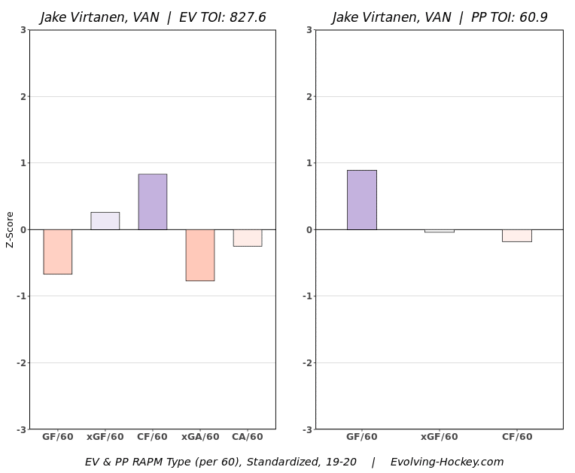
This leads me to one of two conclusions: Virtanen was unlucky, or he took lots of bad shots, likely because he would choose to shoot over making other plays. He did hit 11 posts this season, but given his career shooting percentage of 9.2 and his 2019-20 shooting percentage of 12.0, I don’t think he was overly unlucky.
Virtanen’s vision and overall hockey sense is still what’s holding him back. He’s a fine player, but unless he can improve these factors, it’s safe to say he is what he is as a player.
Salary Cap Implications
So we know what Virtanen does well and what he needs to work on. The bottom line here is he is likely a true talent 40-45-point player with a 20-goal upside who can play a physical game. That’s a nice piece to have in a championship lineup and would typically be a player teams try to keep.
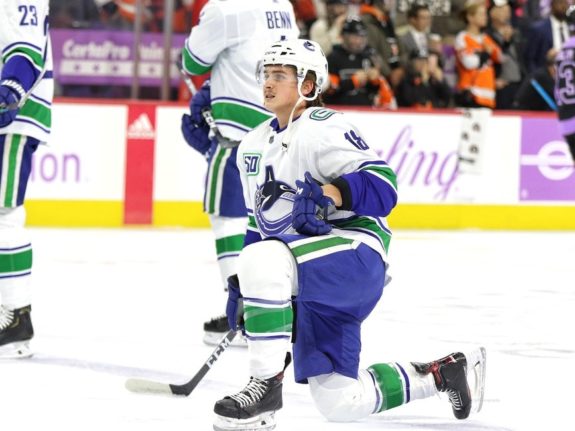
The problem, especially for a team in a position like the Canucks, is the salary cap. The twins at Evolving-Hockey have projected Virtanen is in line for a two-year deal worth a shade over $2.9 million. That’s a substantial raise on his current $1.25 million deal, and with major contracts due for players like Tyler Toffoli, Tanev, and Markstrom, it’s reasonable to question where the oft-debated Abbotsford native fits into the equation.
Realistically, I could even see Virtanen asking for more than that projected number. Before play was stopped, he was on pace for 22 goals and 43 points, right in line with a high-end third-liner or decent second-liner. Unless there’s a way to move more salary out, it may be tough to fit his salary demands under the salary cap.
The other thing to look at is team fit. Assuming the Canucks do everything in their power to keep Toffoli and don’t trade Brock Boeser, that’s the top two right-wing slots taken immediately. I like the idea of Virtanen on the third line, but I’m not convinced he’s a great fit with Adam Gaudette and either of the other regular left-wingers (Antoine Roussel or Josh Leivo). Gaudette and Leivo, in particular, play similar styles to Virtanen, carry the puck into the zone and generate shots.
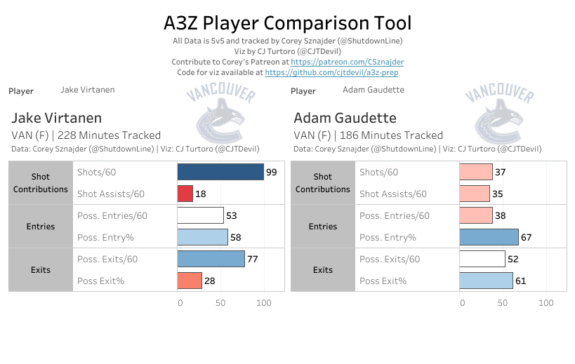
Virtanen needs someone who can distribute and make plays with the puck. That’s why we saw him have such success with Elias Pettersson when they had a chance to play together (who makes everyone better regardless, but the point stands). Earlier in the season, I argued Nikolai Goldobin should be given a shot on that third-line wing for this exact reason. As it stands, I’m not sure where Virtanen realistically fits in the Vancouver lineup.
What’s Next?
Recently on Canucks Twitter, fans have tried comparing his trajectory to famous power forwards like Cam Neely, Todd Bertuzzi, and Shane Doan. Virtanen-mania has gotten so out of hand that Canucks media has had to pump the breaks and decry these claims, and rightfully so.
The Canucks and their fans would love if Virtanen could become a player like that, but given the evidence, I just don’t think it’s possible. He’s too different from those elite power forwards. As Burke and Robinson correctly pointed out, he lacks the vision and processing ability players like Bertuzzi had.
At this point, I believe Virtanen is what he is as a player, and that isn’t a slight on the young forward at all. He’s a valuable player in his own right, but fans shouldn’t expect a star forward ready to emerge at any moment. It’s this same reason why I would be hesitant to give him big money on a new contract, hence why exploring a trade could make sense, especially if there’s a strong return available. A package for a top-four blueliner or even a high draft pick would be enough to sell me on a deal.
TSN1040’s Matt Sekeres recently lit Twitter on fire with his report of Virtanen’s trade value being that of a fifth-round draft pick. If that’s really his value around the league, selling low on a young, valuable player is a bad idea. He’s still a good player and worth more to the Canucks, and should remain in Vancouver for years to come.
